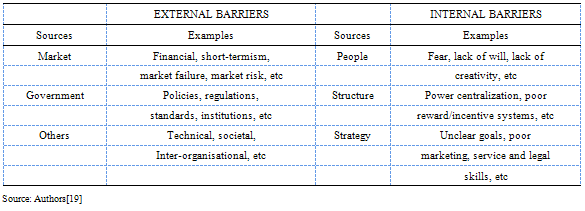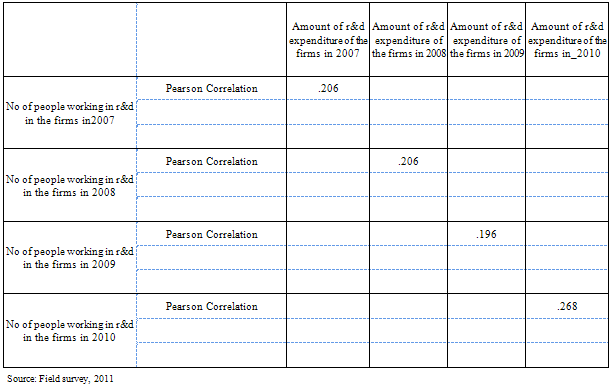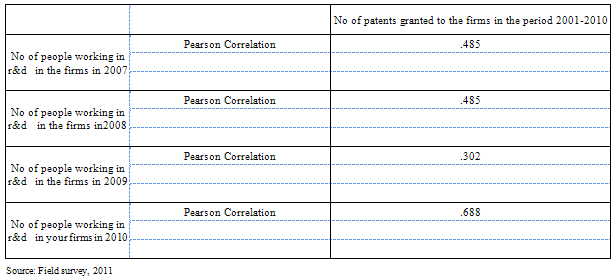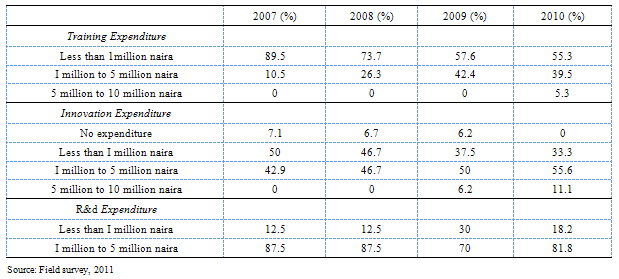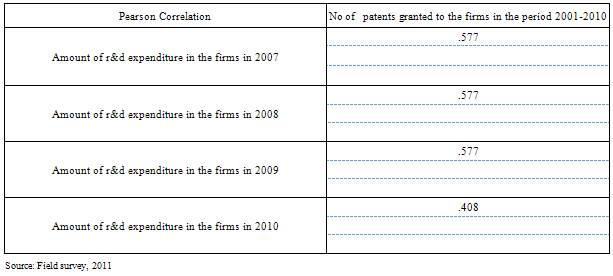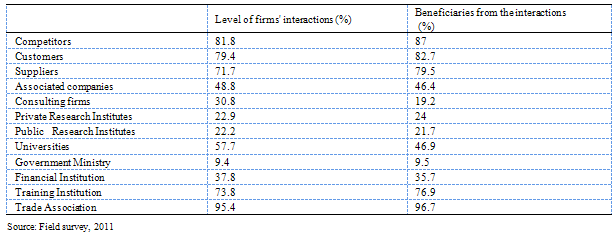-
Paper Information
- Previous Paper
- Paper Submission
-
Journal Information
- About This Journal
- Editorial Board
- Current Issue
- Archive
- Author Guidelines
- Contact Us
Management
p-ISSN: 2162-9374 e-ISSN: 2162-8416
2012; 2(3): 69-79
doi: 10.5923/j.mm.20120203.03
Factors Influencing Innovation and Competitiveness in the Service Sector in Nigeria: a Sub-Sectoral Approach
Jegede O. O. 1, Ilori M. O. 2, Sonibare J. A. 3, Oluwale B. A. 2, Siyanbola W. O. 1
1National Centre for Technology Management
2African Institute for Science Policy Innovation
3Department of Chemical Engineering Obafemi Awolowo University, Ile-Ife, Nigeria
Correspondence to: Jegede O. O. , National Centre for Technology Management.
| Email: |  |
Copyright © 2012 Scientific & Academic Publishing. All Rights Reserved.
This study examined the factors that influence innovation and competiveness in the indigenous Nigeria’s oil and gas servicing firms. This was done with a view to making appropriate strategic recommendations to enhance firm-level innovativeness so as to increase indigenous participation in the sub-sector. The study, which used primary and secondary data sources, was based on a sample of the indigenous oil and gas servicing firms in Nigeria. Four types of questionnaire were administered in each firm. A total of 400 questionnaires were administered on heads of Production, Engineering, Finance and Administration in the firms out of which 70% were returned and found suitable for analysis. This was supplemented with field observations and interviews. Secondary data were sourced from the internet and other published sources. The data so obtained were analysed using descriptive and inferential statistics.The technological factors that accounted for the innovation performance included the educational qualifications, training and prior work experience of the heads of technical department, number of r&d staff and training, innovation, and, r&d investment. The important non-technological factors included interaction with competitors, consumers, suppliers and training institution. In conclusion, our study found out that the most important factors that influence innovation in the sub-sector are r&d expenditure and training.
Keywords: R&d Expenditure, R&d Staff, Training, Educational Level, Innovation
Article Outline
1. Background
- The Nigerian economy since the last four decades has become reliant on the oil and gas sector, which accounts for more than 90 percent of export revenues and 41 percent of her Gross Domestic product (GDP)[45]. But despite the huge investment of Nigerian government towards this sector of the economy, there has been no significant development[45]. The local content (LC) in the industry is still very low[45]. This situation can be attributed to low technological capability, low manpower development and lack of sustained national economic development[49]. The low LC in the Nigerian oil and gas industry (OGI) may also have resulted from deficient capitalisation arising from the tendency of Nigerian entrepreneurs to operate as ‘one man’ businesses; capital and structural deficiencies associated with poor training and low managerial ability; and inability to attract funds due to lack of suitable collateral and positive corporate capital and structural deficiencies associated with poor training and low managerial ability; and inability to attract funds due to lack of suitable collateral and positive corporate image[43]. Other reasons for the low local content in Nigeria to include low technological capacity, lack of funding from financial institutions, inadequate and incoherent policies/legislations, inadequate infrastructure, unfavourable business climate, lack of partnering between indigenous contractors and their foreign counterpart and low innovation capability[2; 20; 44; 42]. Innovation can be triggered in many ways: Bottlenecks in production within a firm, changes in technology, competitive conditions, international rules or domestic regulations, environmental or health crises and even wars have been known to stimulate a process of innovation[14; 9; 39; 52]. Innovation is highly essential for the growth and sustainable competitiveness of Small and Medium Enterprises[SMEs][21; 53; 56].In recent years, a lot of study has been done to find out which factors that influence SMEs’ innovation. Literature attempts to build a more thorough theoretical understanding of what works and what does not, and to validate practical interventions[3; 25]. These studies revealed that activities directed towards innovation show a relationship with a considerable number of variables including age[23]; geography[22]; r&d[7], staff characteristics[50]; and collaboration with several actors like customers[26], suppliers[31] and knowledge centres[22; 41].
|
1.1. Barriers to Innovation
- Majority of firms/organizations have been observed not to be adequately innovative[55]. One way to examine the reasons for this inadequacy is to identify those factors that inhibit innovation. There is a multitude of barriers and a classification is useful in studying them. Several classification schemes have been used but one of the most common which classifies barriers into external and internal[19].
2. Methodology
- The framework adopted in this study is based on established relationships in the literature on technological capabilities and represents a little modification on the one applied by[50] in a study of the determinants of innovation capability in small high-tech firms in the United Kingdom (UK). Sources of innovation capability:This study considered two sources of innovation capabilities viz technological sources and non-technological sources.The technological sources were measured through three main variables as follows:a. Technological sources of innovation capability:ⅰ.The professional background of the heads of technical departments was captured through three variables. The educational qualification was represented by multiple-choice measures of management, science and engineering and other academic degrees obtained. Prior work experience abroad was represented as the number of years that the chief executive worked in any of small enterprises, large corporations, and university or related institutions. Prior training experience abroad in small enterprises, large corporations, and university or related institutions to current work were measured on a likert scale. ⅱ. Human resources of the firms was measured by variables representing the extent of organisational learning and the working proportion of r&d staff in total workforce was also considered[50] ⅲ. Investment effort was captured by variables representing innovation, r&d and training investment[6; 24]. b. Non-technological sources of innovation capability:ⅰ. Networking and collaboration was captured by the incidence of contacts with external agents. for example, relationships with customers, suppliers, enterprises in related lines of business, financial institutions, universities, research institutions, training institutions, service providers and industry.ⅱ. Proximity advantages from networks measured the geographical proximity advantages associated with the above network interactions and these were measured by asking the respondents to indicate, whether or not a proximity advantage was attached to each of the interactions. ⅲ. Institutional support measured by whether or not firms had received financial support from government or other forms of support from other institutions such as trade associations. The study focused on the indigenous oil servicing firms in Nigeria and some of these firms were purposefully selected. Data was collected from the firms through the use of a structured questionnaire administered on the four departments identified as relevant to the study. These are production, engineering, finance and administration in the selected firms. 400 questionnaire were administered by hand delivery. 280 questionnaire which were returned with accuracy used in the analysis. The data was aggregated such that analysis was done on firm level (i.e 4 questionnaire were administered in each firm; one questionnaire for each department highlighted above).
3. Results and Discussion
3.1. Technological Factors Influencing Innovation Capability in the Firms
- From the conceptual framework, three technological factors were considered to influence innovation capability in the firms[50]. This study considered the educational background of the head(s) of technical department(s), the skill of the human resources (especially in the research and development department) and the internal technological efforts (training, research and development, and innovation expenditure) of the firms to decipher the level of the firms’ capability for technological innovations with the reference period.
3.1.1. Educational Background of the Head(S) of Technical Department(S)
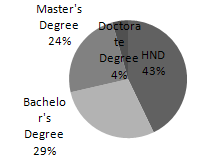 | Figure 1. Heads of Production Department by Qualification |
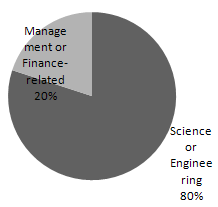 | Figure 2. Heads of Production Department Degree by Discipline |
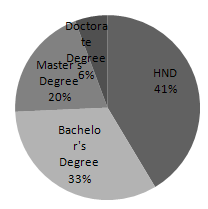 | Figure 3. Distribution of the heads of Engineering Department by Qualification |
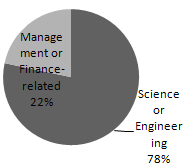 | Figure 4. Distribution of the heads of Engineering Department Degree by Discipline |
3.1.1.1. Production Department
- As summarized in Figure 1, 43 % of the heads of production department in the firms surveyed have Higher National Diploma, while 29% have Bachelor’s Degrees, 24% have Masters Degree and 4% have Doctorate Degree. Also, 80% of the heads of production department have degrees in Science or Engineering field while 20% have degrees in Management or Finance-related field (Figure 2).
|
|
3.1.1.2. Engineering Department
- Information gathered from this study showed that 41% of the heads of engineering department have Higher National Diploma, while 33% have Bachelor Degrees, 20% have Masters Degree and 6% have Doctorate Degree (Figure 3). Those who obtained degrees in Science or Engineering field were 78% (Figure 4). Also, 12.9% of the heads of engineering department went for training in other African Countries, 10% in Europe, 14.3% in America, 4.3% in South America, 8.6% in Asia and 5.7% in Australia at some point in time. While 10% of the heads of the engineering department obtained a degree in Europe, 1.4% in North America while 1.4% of the heads of the engineering department had previously worked in other African Countries.However, table 2 showed that the educational level of the heads of engineering department is weakly correlated with process improvement. This implies that other exogenous factor affect new improvement rather than education level of the head of the department.The evidence for the UK and similar developed western economies suggests that the average estimate of the gross rate of return to a year’s additional education ranges between 5 and 10 per cent. One of the most recent studies in UK finds that the average annual return of undertaking an extra year of full-time education is 5.5 per cent for men and 9.3 per cent for women[8]. These figures are only averages for the population as a whole and it would appear that these returns vary significantly by the type of qualification obtained. These estimates also ignore part-time education undertaken by a large number of individuals including the apprentices.
|
|
|
|
3.1.2. Skill of Human Resources
- Evolutionary theory suggests that diverse sources of information allow firms to create new routines through combinations of technologies and knowledge, leading to more opportunities to dynamically innovate and select competitive technology[1]. The fact that firms require an adequate stock of skilled manpower and the role played by firm-level investments in training to enhance this pool has been established in the innovation literature[1; 50]. More recent research has indeed proven that firms that continually invest in staff training tend to be more capable to innovate.Innovation initiatives tend to depend heavily on employees' knowledge, expertise, and commitment as key inputs in the value creation process[60]. The knowledge-based view depicts firms as repositories of knowledge and competencies[17; 54]. According to this view, prior studies recognize the knowledge and competencies of human resource as valuable assets for firms because of their characteristics of firm-specific, socially complex, and path-dependent[12; 59; 60; 27]. Human resource practices (HR practices) are the primary means by which firms can influence and shape the skills, attitudes, and behaviour of individuals to do their work and thus achieve organizational goals[12; 34].Previous literatures have paid attentions to the link of HR practices and organisational outcomes such as productivity, flexibility, and financial performance[32; 60; 47; 36; 12], but the understanding needs to be extended to encompass innovation performance[29]. Accordingly, the present study was also carried out to address the link of HR practices and firm's innovation performance from the knowledge-based perspective (Table 3).Table 3 shows that the amount of r&d expenditure and the number of people working in the r&d department are weakly correlated. This translates that the increase in the number of people working in r&d department within the period 2007-2010 does not match the increase in the amount the firms spent on r&d. The consequence of this is that those in the r&d department would not have enough tool and fund to work thereby lowering the expected output of their r&d outputs on innovation. The firms would need more numbers of staff in the r&d department to boost the innovation in the sub-sector and also for the firms to stalk out market position. However, the number of r&d workforce is significantly correlated with number of patents granted to the firms (Table 4). This implies that the r&d workforce, if given the right resources to work with may turn out more innovations than at present.
3.1.3. Firms’ Investment in Training, Innovation and Research & Development
- R&d expenditures in developing countries depend on the firm’s innovation strategy, i.e., innovating or non-innovating. This means that firms invest in r&d either to adapt foreign technologies to the Nigerian market or to enhance their competitiveness when facing a greater foreign competition without innovating[11]. It should be noted that in such context r&d activities are not well structured (with a separate department and full-time r&d personnel) and could be implicit activity. For instance, some of the surveyed firms thought they are not innovating so, they considered that they do not have r&d activities whereas, they are expending on r&d. The relationship between r&d activity and the firm's performance is far from being a recent field of research, as shown among others in surveys by[18; 37] and[33]. It is now well-known that, besides the impact of the firms’ own r&d expenses, positive externalities stem from the foreign firms’ r&d activity, i.e., there are diffusion or spill over effects. However, the indigenous firms did not benefit from this technological spill over probably due to low absorptive capacity. So the surveyed firms invest in their own r&d to be able to utilize the technological knowledge, which is externally available. Accordingly, it could be established that while r&d obviously generates patents and innovations, it also develops the firm's ability to identify, assimilate, and exploit knowledge from the environment (Table 6). Majority (89.5%) of the firms that engaged in staff training within the reference period spent below a million naira per year (Figure 5) but the trend became reversed as the years progressed. Like the training expenditure, the innovation expenditure increased as the years progressed. The figures in table 4.15 above are very low compared with the amount spent in the SMEs in developed countries. For example, in the case of U.S companies[4], German enterprises[16], Spanish firms[13], Flemish companies[58] and French firms[38; 46] who ascribe a large portion of their profit to innovation activities.
3.2. Non-Technological Factors Influencing Innovation in the Firms
- The non-technological factors influencing innovations in the firms considered in this study were interactions, collaborations, availability of government and other institutional support. Each of these was considered in this sub section with the results n them from the study presented and discussed.
3.2.1. Interactions and Collaborations
- This study considered networking and collaboration as well as the advantages that firms might derive from these when located close to the actors involved in the networks. Table 4.17 shows that the firms interacted more with their trade association than with most other actors. Several previous studies[35; 50] have highlighted the importance of a number of stakeholders within an innovation system that firms may network or collaborate with. Evidences exist in favour of customers, suppliers, trade associations, higher education and research institutions, among others as helpful sources of information for the firms’ innovation activities.[15] showed that customers probably matter more than any stakeholder in innovation. The authors found out that all the firms surveyed were sub-contracting while up to 78% of the firms outsource to other indigenous firms. So, there is strong interaction among the firms in oil and gas servicing industry. The study also revealed that firms collaborated with competitors, suppliers, consulting firms, financial institutions and trade associations to solve its problems. In spite of the firm’s proximity to knowledge centres, the study showed low evidences of collaboration with government ministries, research institutes and universities. Hence, there were very low substantive proximity benefits gained by the firms from the government ministries, universities and research institutes (Table 4.17).In contrast with the trend in the literature, the occurrence of proximity of knowledge centres among the firms was very low[5; 57; 51] except for the training institutions (Table 7) this is in spite of the fact that all the firms are located in the same city with at least a university. Perhaps this could be explained by the general economic paradigm that firms require a certain level of absorptive capacities (usually approximated by firms’ proportion of r&d staff, engineers or scientists) to be able to assimilate scientific knowledge and to benefit optimally from partnerships with knowledge centres, especially universities[10; 51]. Although it was difficult to empirically evaluate the firms’ absorptive capacity because data gathered on staff profiles were largely partial and unreliable, the information gathered from the interviews conducted pointed out that the absorptive capacities of the firms in the indigenous oilfield servicing sub-sector was quite low. On the other hand, majority of the firms admitted close location to, competitors (87%), customers (82.7%), suppliers (79.5%), training institutions (76.9%) and particularly trade associations (96.7%) had been very beneficial to them (Table 4.17). This seems to suggest that it could have been easier for the firms to explore and seize the advantages from being close to these actors since no considerable level of absorptive capacity is required. An implication that could be drawn from the foregoing discussion is that in facilitating industry-academic relations, both proximity and firm-level absorptive capacities are critical and require attention from all stakeholders.
3.2.2. Government Support and Policy
|
|
4. Conclusions
- The results showed that oil and gas servicing firms in Nigeria, which are all SMEs, demonstrated low levels of innovation capabilities. Although some product, process, with traces of diffusion-based innovation were found, organisational innovations were at the heart of the innovation activities of the firms. In addition, it was found that these firms operate within a weak Sectoral Innovation System (SIS) especially with government and knowledge institutions. It is to be concluded from these that firms operating within such contexts are not necessarily innovation-inactive. However, they might not be able to engage in implementing product and process changes that require much knowledge and financial investments. Nonetheless, organisational changes that are not necessarily based on advanced investments are not beyond the reach of these firms. Given the generally deficient state of the innovation influencers, it is not surprising that the firms were more capable to implement changes in organisation and processes than what they would do with their products and embodied knowledge from elsewhere. The importance of firm-level investment in organisational learning is further brought to the fore by the findings. Firms are required to consciously make investments in developing a capable stock of human capital. When this happens within a network of strong institutions and a favourable economic ambience, a firm will definitely be much more capable for innovation. This is to say that while the firms make efforts to build capabilities, the success of their efforts depend directly on the supportiveness of the environmental context within which they operate.An importantly new knowledge advanced by this study is the specific role that the trade association plays in facilitating firm-level innovation capability. It has been indicated by the results that trade associations have a central role to play in facilitating firm-level innovation especially in the developing country context. Few earlier studies have identified such associations as important in the processes that lead to the build-up of firm-level capabilities and the knowledge available on the specific roles that they are capable of playing is still very sparse. Obviously, their roles now transcend mere activism and protection of rights but also involve covering resource deficiencies for member firms, helping member firms learn and creating access to innovation-friendly support. Firms were seen to have benefitted from trade association through knowledge exchange, the creation of a sectoral innovation system and protection from foreign competition through the maintenance of a high quality standard. Much is to be gained by the nation if all trade associations are encouraged and assisted in fulfilling these roles. The need for a strong innovation system is also indicated by the findings of this study. Firms were seen not to have received much support from knowledge institutions and even from government. Specifically, diffusion-based innovation was very low. The few firms that succeeded in doing this were those that on their own had significant external resource endowments by virtue of belonging to a multinational group. Most of the indigenous firms were largely unable to muster enough resources on their own to engage in activities that would give rise to that kind of innovation. Thus, stronger government-finance-research-industry linkages that would resource deficiencies are critical to firm-level innovativeness.
5. Recommendations
- These suggestions which are best considered as strategic implications of the study are laid out in the next sub-sections
5.1. Strategic Implications for Policymaking
- To enhance the innovation capability of indigenous firms and ensure that this capability becomes more expressive, it is particularly important to: ⅰ. drive interactions among educational/ research institutions and industrial firms with appropriate policies;ⅱ. encourage firms by reducing taxes and tariffs in a competitive manner;ⅲ. create an enabling political and economic environment characterised by strong institutions, access to funds and dynamic but stable policy regimes;ⅳ. address the challenge of infrastructural constraints as a matter of urgency. Firms would be well assisted if they can make use of highly-subsidised public utilities in their production; and ⅴ. attract key actors, particularly suppliers, closer to the firms through government interventions because firms will not always have what it takes to attract these actors. Ways to do this include encouraging suppliers of materials and machinery to establish local workstations and outlets, with explicit support from government. This will reduce the cost of procurement that accrues to domestic enterprises.
5.2. Strategic Implications for Practice
- For the indigenous firms, the following specific suggestions are useful for the build-up of innovation capability:ⅰ. firms are required to improve their absorptive capacities by creating regular programmes for staff development, and making the necessary investments.ⅱ. firms should make efforts to interact with government, knowledge institutions and other key actors of the sectoral innovation system.
 Abstract
Abstract Reference
Reference Full-Text PDF
Full-Text PDF Full-Text HTML
Full-Text HTML